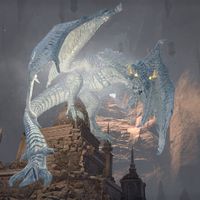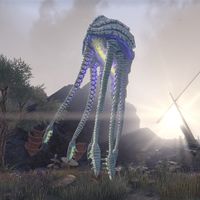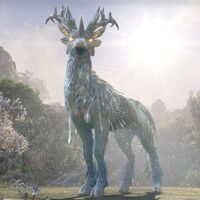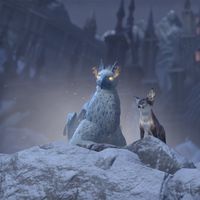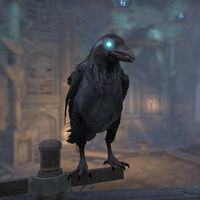Lore:Luminary
The Luminaries of Magic (Luminaries for short) are mysterious beings of pure magic[1] that are described with the Old Bretic word Alien meaning "stranger". This is due to the fact that they see the world differently from mortal-kind, and no one, not even the Luminaries themselves, know what they actually are.[2][3] They have however chosen the forms and names of various creatures from Nirn that suit their personalities.[1] The Netch chose its form for its buoyancy and its ability to control magicka,[4][5] while the Gryphon wishing to serve as a peacekeeper took on the shape of a creature that is often found in symbols predating mankind.[6] The Dragon chose its form for its majesty,[7] while the Indrik claims there was simply no other form it could have been.[8] The name for them, "Luminaries of Magic", was given to them by Ulfsild the Evergreen.[1]
Some theories proposed by Ulfsild as to what they are include that they are fallen tears of Aetherius, creations by the Aedra to guide and protect mortals, or a natural part of the cycle of magic.[3] Members of the Mages Guild have given some thought as to what they are as well, some which align with some of Ulfsild's theories, while others differ. Some Guild mages believe they were sent by the Aedra for some purpose, but for why varies. Some see them as proxies of the Divines or even as harbingers for the return of the Aedra. Others see them as Aetheric constructs of pure magicka that manifest from mortal's expectations. Others lean the opposite way, that perhaps they are some kind of disguised Daedra that are willing to work with mortals. Another theory presented is perhaps that they are ascended ancestors that reincarnated into this form, though the Luminaries themselves hate this theory.[2]
The Luminaries of Magic also have their own opinions on how they came to be, each with contridicting answers. The Indrik believes itself to have resulted as a manifestation of thought,[3] while the Dragon does not care for its origins. The other Luminaries believe their origins to be magical, such as the Indrik resulting from a feat of magic,[3] and the Gryphon being born from the reservoir left behind from the sacrifice of a sage's ritual.[6] The Netch is known for giving multiple tales on its creation, though it has claimed once that it came from a magical accident.[3][4]
History[edit]
First Era[edit]
Though she did not know it at the time, Ulfsild had met the Indrik Luminary in her youth, who saved her from being trampled from a herd of mammoths that she had attempted to collect wool from. Her clan laughed at her thinking she had some fanciful dream, with all that was left to show was the Indrik's feather which she kept as an accessory on her hat as a keepsake. After she met Shalidor, she encountered a natural Indrik and her fawn in Auridon, which led her to realize what she had saw. Her memory restored, she saw to learn more about the creatures and found an old story called the Fable of the Indrik.[9] Ulfsild, who was born with a rare gift of being able to see the flow of magicka on Nirn, noticed that certain fables such as this story glowed with a certain essence, which she interpreted as clues that led her to discovering the creatures she called Luminaries.[10] Collaborating with these entities, she developed the art of Scribing, the precursor to the modern Spellcrafing system.[1][UOL 1]
As she was about to lose her life's work to the Shivering Isles, using the evidence she found during her time with the Luminaries, Ulfsild enacted a ritual where a new being was born from her essence to safeguard the future of the Scholarium, the Crow Luminary.[1] The creation of her own Luminary took an enormous toll on her that would take years to recover from.[11]
Gallery[edit]
References[edit]
- ^ a b c d e The Crow's dialogue in ESO
- ^ a b Loremaster's Archive - Scribing — Votary Nahila
- ^ a b c d e Ulfsild's Notes: The Origin of Luminaries — Ulfsild
- ^ a b The Netch's dialogue in ESO
- ^ The Secret of the Netch — The Netch
- ^ a b The Gryphon's dialogue in ESO
- ^ The Dragon's dialogue in ESO
- ^ The Indrik's dialogue in ESO
- ^ Fable of the Indrik
- ^ Ulfsild's Echo of the Lens' dialogue in ESO
- ^ Ulfsild the Evergreen's dialogue in ESO
Note: The following references are considered to be unofficial sources. They are included to round off this article and may not be authoritative or conclusive.
|
|||||||||||||||||||||||||||||||||||||||||||

